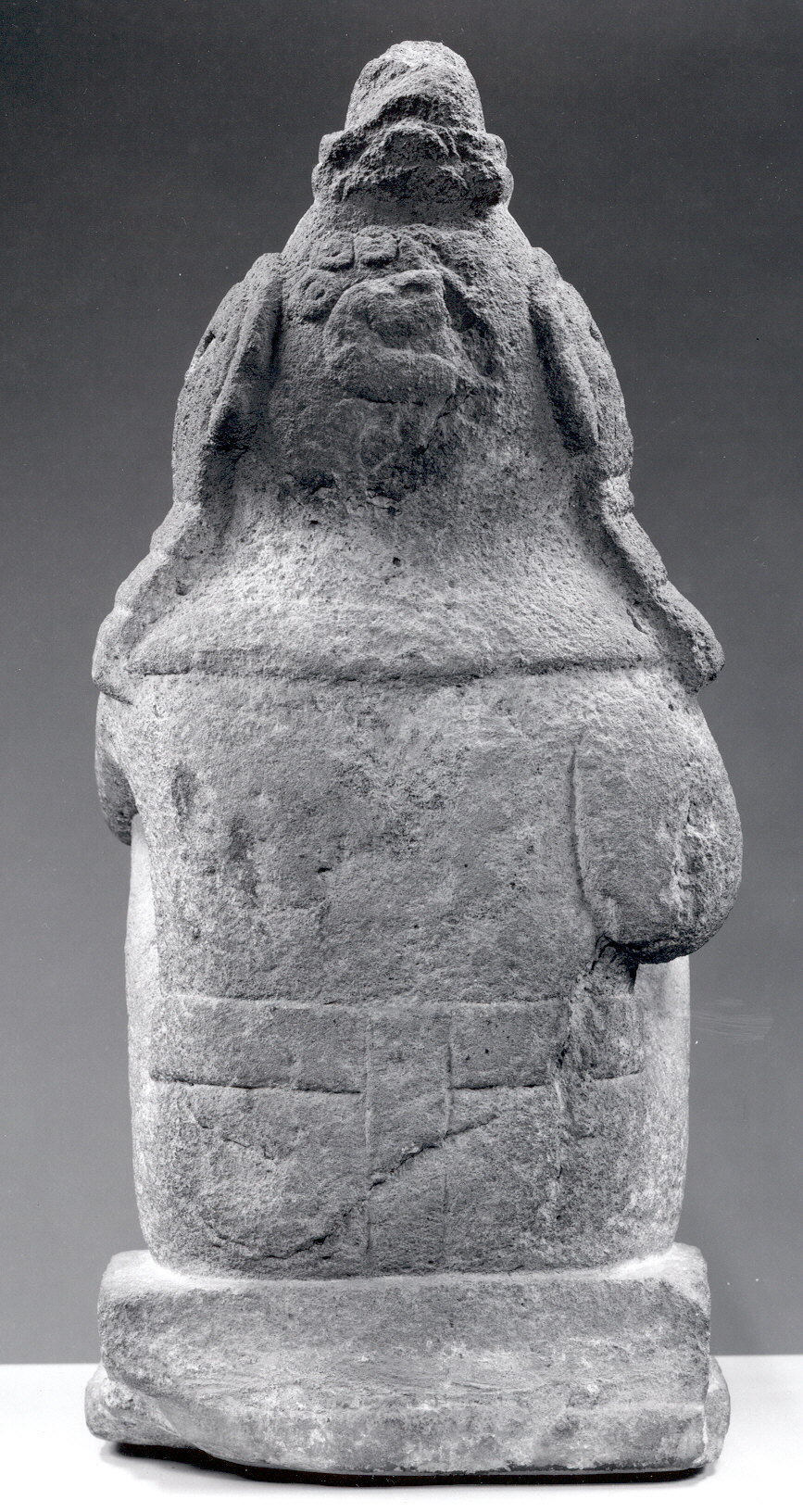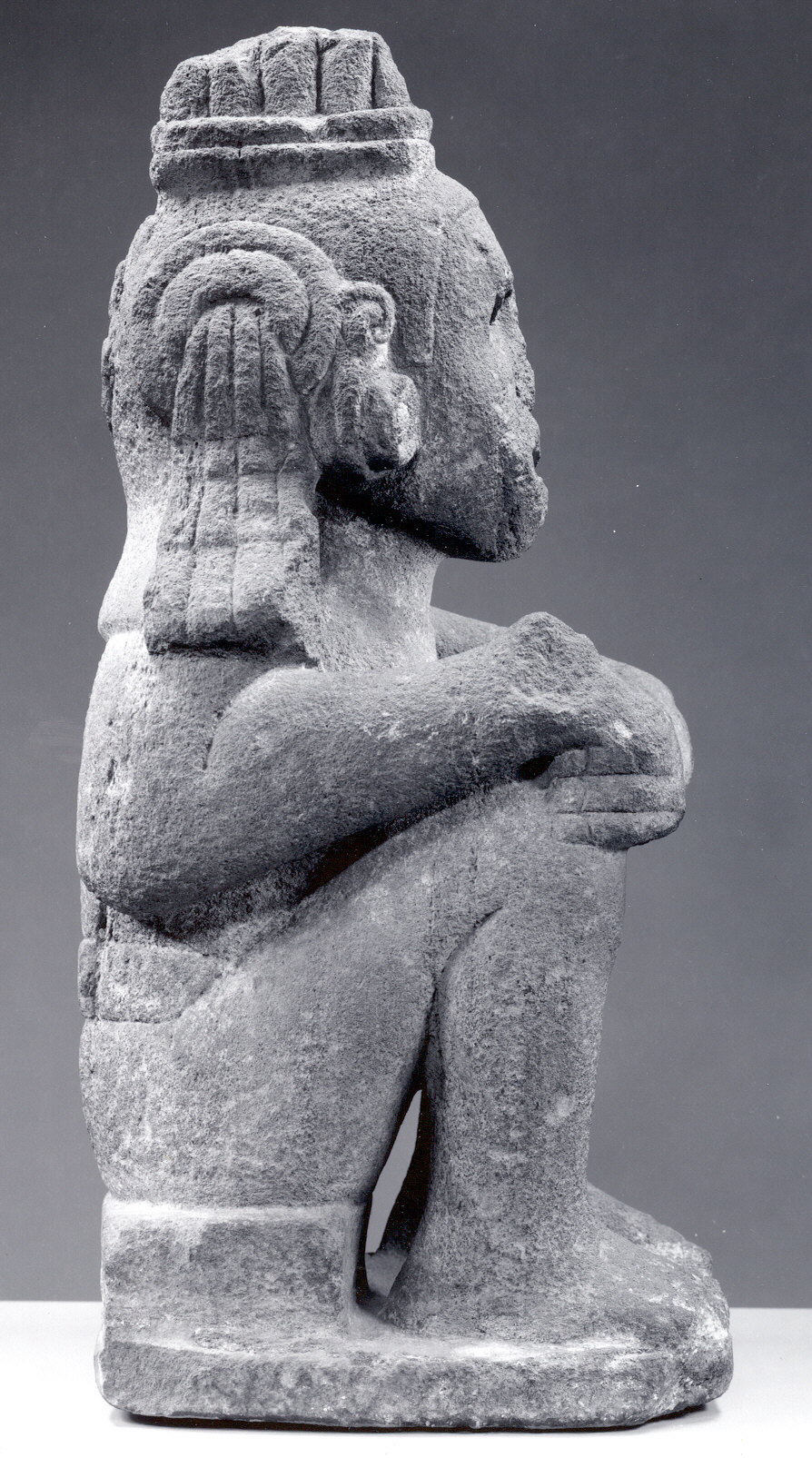Seated Deity (Macuilcoatl)
Not on view
This sculpture depicts a seated male with his legs drawn up to his chest. His posture is straight and open with his left forearm resting across both knees. The figure’s right hand, which was likely broken in antiquity or during the early Colonial period, is modeled around a small void. The figure’s open hand likely once held a banner, or flag-tipped staff.
Bearing the image of a hand carved in shallow relief across its lower jaw, this Aztec standard bearer represents one of the pre-Hispanic deities known as the Macuiltonaleque, or "lords of the five souls" (macuil, "five" + tonalli, "soul"). By reading the glyph sculpted on the reverse of the statue’s head, which depicts a coiled serpent surrounded by five dots, we are able to identify this figure as Macuilcoatl, or "5 Serpent." Associated with feasting, gambling, and games of chance, the youthful Macuiltonaleque embodied notions of pleasure, excess, and disease in pre-Hispanic Central Mexico. As denizens of the night, they were also thought to represent exalted warriors who, upon dying in battle, rose to the heavens to carry the sun disc on their backs from dawn till its midday zenith.
As spiritual guides, the Macuiltonaleque inhabited, or "possessed," the five fingers of native priests and mystics so that the latter might be allowed to predict future events, diagnose disease, or act as matchmakers. To complete this possession, it is said that the priest first had to cake his hand in a chalky salve of white lime and tobacco. Then chanting a series of sacred incantations, he called upon the gods of pleasure to descend into his ashen digits and thus allow him to articulate the prophetic visions revealed in his tonalamatl ("book of days"), a type of hand-made divinatory book used throughout Mesoamerica. The hand positioned under this standard bearer’s mouth thus underscores his role as a medium (or "mouthpiece") for these divine beings.
As with many of the conventionalized sculptural types associated with the Aztecs—such as the chacmool (a recumbent male figure holding an offering bowl above his chest) or the Atlantean "sky-bearer" figures—the origins of the standard bearer can be traced back to the Toltec culture of the Early Postclassic period (ca. 900–1000). Illustrations of standard bearers began appearing in European chronicles by the end of the sixteenth century. In his Primeros memoriales (ca. 1561), for example, the Franciscan friar Bernardino de Sahagún depicts a pair of figures—identified by their names glyphs as "5 Lizard" and "5 House"—holding plume-tipped staffs and crouching to either side of the Templo Mayor, the central religious shrine of the Mexica-Aztecs. (Aztec elites living in the imperial capital of Tenochtitlan referred to themselves as "Mexica," which is the origin of the modern-day name of Mexico.) Each of the figures depicted in Sahagún’s manuscript is adorned with a feather headdress and loincloth and displays a white, multi-lobed emblem over the mouth, analogous to the hand-on-jaw motif seen here. As most standard bearers lack any verifiable archaeological context, this colonial eyewitness account provides reliable evidence that such works were originally intended to frame and aggrandize important temples in the Aztec world.
William T. Gassaway, 2014–15 Sylvan C. Coleman and Pamela Coleman Fellow
-----
Resources and Additional Reading
Boone, Elizabeth H. Cycles of Time and Meaning in the Mexican Books of Fate. Austin: University of Texas Press, 2007.
Easby, Dudley T., Jr., "A Man of the People." The Metropolitan Museum of Art Bulletin XXI, no. 4 (December 1962), pp. 133–140.
Hernandez Pons, Elsa C. "Sobre un conjunto de esculturas asociadas a las escalinatas del Templo Mayor." In El Templo Mayor: excavaciones y estudios, edited by Eduardo Matos Moctezuma, pp. 221–232. Mexico: Instituto Nacional de Antropología e Historia, 1982.
Klein, Cecelia. "Ideology of Autosacrifice at the Templo Mayor." In Aztec Templo Mayor: A Symposium at Dumbarton Oaks, 8th and 9th October 1983, edited by Elizabeth H. Boone, 293–370. Washington, D.C.: Dumbarton Oaks Research Library and Collection, 1988.
Nicholson, Henry B. "Major Sculpture in Pre-Hispanic Central Mexico." In Handbook of Middle American Indians, edited by Gordon F. Eckholm and Ignacio Bernal, 10:1:92–134. Austin: University of Texas Press, 1971.
Pohl, John M. D. Sorcerers of the Fifth Heaven: Nahua Art and Ritual of Ancient Southern Mexico. Program in Latin American Studies Cuadernos No. 9. Princeton: Princeton University, 2007.
Sahagún, Fray Bernardino. Primeros memoriales. 2 vols. Paleography of Nahuatl text and English translation by Thelma Sullivan. Norman: University of Oklahoma Press, 1993–98.
Due to rights restrictions, this image cannot be enlarged, viewed at full screen, or downloaded.
This artwork is meant to be viewed from right to left. Scroll left to view more.





